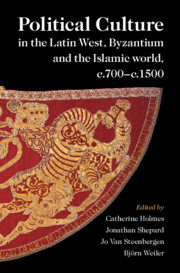 Political Culture in the Latin West, Byzantium and the Islamic World, c.700–c.1500
Political Culture in the Latin West, Byzantium and the Islamic World, c.700–c.1500 Book contents
- Political Culture in the Latin West, Byzantium and the Islamic World, c.700–c.1500
- Political Culture in the Latin West, Byzantium and the Islamic World, c.700–c.1500
- Copyright page
- Contents
- Figures and Maps
- Contributors
- Preface and Acknowledgements
- Abbreviations
- General Maps
- 1 Political Culture in Three Spheres
- 2 Reflections on Political Culture in Three Spheres
- Part I Sources
- 3 Comparing the Three Spheres through the Prism of the Sources
- 4 The Latin West
- 5 Byzantium
- 6 The Islamic World
- Part II Historical Contexts
- Part III Norms, Values and Their Propagation
- Part IV Practice and Organisation
- Part V Conclusions
- Appendix
- Glossary
- Index
5 - Byzantium
Sources
from Part I - Sources
Published online by Cambridge University Press: 11 August 2021
- Political Culture in the Latin West, Byzantium and the Islamic World, c.700–c.1500
- Political Culture in the Latin West, Byzantium and the Islamic World, c.700–c.1500
- Copyright page
- Contents
- Figures and Maps
- Contributors
- Preface and Acknowledgements
- Abbreviations
- General Maps
- 1 Political Culture in Three Spheres
- 2 Reflections on Political Culture in Three Spheres
- Part I Sources
- 3 Comparing the Three Spheres through the Prism of the Sources
- 4 The Latin West
- 5 Byzantium
- 6 The Islamic World
- Part II Historical Contexts
- Part III Norms, Values and Their Propagation
- Part IV Practice and Organisation
- Part V Conclusions
- Appendix
- Glossary
- Index
Summary
This chapter assesses the significance of a variety of genres of written and material sources for an understanding of political culture in Byzantium, including narratives and chronicles, encomia, orations, ceremonial handbooks and lists, monuments, silks, coins, archival documents, lead seals and letters. It distinguishes between narratives produced at the centre of Byzantine political life and those produced by outsiders: the former not simply windows into Byzantine political culture but integral elements of that culture, projecting the norms and expectations of the governing elite; the latter offering alternative perspectives, valuable for plugging chronological gaps but also as correctives to the propaganda that characterises so much Byzantine historiography. Few administrative records survive from Byzantium, especially compared to the Latin west, although legions of lead seals point to archives once far richer. Our surviving sources, particularly speeches, suggest that only in the later period were alternatives to the prevailing political order countenanced, and even then, despite a loss in territorial reach, the emperor’s court still formed the focal point of political life.
- Type
- Chapter
- Information
- Political Culture in the Latin West, Byzantium and the Islamic World, c.700–c.1500A Framework for Comparing Three Spheres, pp. 77 - 100Publisher: Cambridge University PressPrint publication year: 2021
